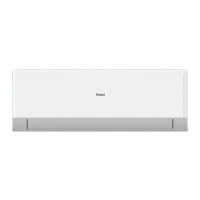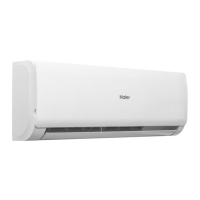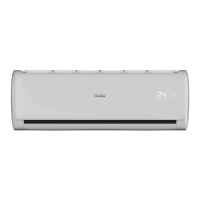Do you have a question about the Haier AS35S2SF1FA-BH and is the answer not in the manual?
Explains the meaning of each character in the model number.
General safety precautions and pictograms used in the manual.
Instructions for checking embedded wire diameter and continuity before installation.
Warnings and precautions to be followed during repair work.
Post-repair precautions and checks to ensure safety and proper function.
Procedures for inspecting the unit after repair work is completed.
Explanation of the meaning of icons used throughout the manual.
Highlights A-PAM DC inverter and long-distance air supply capabilities.
Covers quiet operation, comfortable sleep, turbo mode, DIY auto, auto restart, and timers.
Details low-temperature heating, heating maintenance, and multi-unit compatibility.
Describes integrated valve cover, 2-way piping, easy cleaning, and display type.
Specifies voltage, phase, and frequency requirements for the unit.
Lists rated cooling/heating capacity, power consumption, and efficiency ratings.
Details dimensions, weight, color, and sound level specifications.
Provides specifications for fan, heat exchanger, air filter, and temperature control.
Describes the function of the room temperature sensor.
Explains the purpose of the evaporator temperature sensor.
Illustrates the refrigerant flow during cooling operation.
Shows the refrigerant path during heating operation.
Lists and identifies connectors on the control PCB for various components.
Details additional designations like switches, varistors, and fuses on the PCB.
Overview of the system's primary operational modes and controls.
Explains how the system automatically determines and switches operating modes.
Details temperature control, airflow speed, and features during cooling.
Describes the temperature control and features for dehumidifying operation.
Covers temperature control, fan speed, and special features for heating.
Explains how to activate and use the strength operation mode.
Details the conditions and effects of mute operation for heating and cooling.
Describes the Nano-Aqua function for air purification.
Explains how to set 24-hour on/off timers for system operation.
Details the automatic temperature adjustment during dormant mode.
Describes the function of the urgency button for testing and status display.
Explains the protection mechanism against indoor heat exchanger frosting.
Details the protection against high coil temperatures during operation.
Describes actions taken when indoor system operation mismatches outdoor system.
Explains how error codes are stored and displayed.
Outlines methods to confirm various sensor and communication abnormalities.
Describes how to operate the unit independently from the outdoor system.
Details how the system status is saved during power interruptions.
Steps for running the system's internal test program.
Describes a function that speeds up the CPU for testing.
Explains how to use a room card for control and operation.
Table listing resistance values for the room sensor at different temperatures.
Tables showing resistance for room and pipe sensors across temperature ranges.
Provides detailed measurements and diagrams of the indoor unit's physical dimensions.
Shows the center of gravity for the indoor unit.
General warnings before performing diagnostic procedures.
Lists common symptoms and corresponding troubleshooting steps.
Explains error codes indicated on the indoor display and their meanings.
Details troubleshooting for thermistor sensor failures.
Guides on how to diagnose and resolve EEPROM errors.
Troubleshooting steps for issues with the indoor fan motor.
Diagnosing and resolving problems with the outdoor fan motor.
Explains IPM protection faults and their resolution.
Troubleshooting for compressor over-current protection.
Diagnosing communication errors between IPM and outdoor PCB.
Identifies and resolves power supply voltage issues.
Troubleshooting for overheat protection related to discharge temperature.
Details diagnosing communication faults between indoor and outdoor units.
Explains how to diagnose issues with compressor rotor position detection.
Addresses protection activated by high heat exchanger temperature in heating mode.
Shows the electrical connections for the indoor unit components.
Explains the meaning of each character in the model number.
General safety precautions and pictograms used in the manual.
Instructions for checking embedded wire diameter and continuity before installation.
Warnings and precautions to be followed during repair work.
Post-repair precautions and checks to ensure safety and proper function.
Procedures for inspecting the unit after repair work is completed.
Explanation of the meaning of icons used throughout the manual.
Highlights A-PAM DC inverter and long-distance air supply capabilities.
Covers quiet operation, comfortable sleep, turbo mode, DIY auto, auto restart, and timers.
Details low-temperature heating, heating maintenance, and multi-unit compatibility.
Describes integrated valve cover, 2-way piping, easy cleaning, and display type.
Specifies voltage, phase, and frequency requirements for the unit.
Lists rated cooling/heating capacity, power consumption, and efficiency ratings.
Details dimensions, weight, color, and sound level specifications.
Provides specifications for fan, heat exchanger, air filter, and temperature control.
Describes the function of the room temperature sensor.
Explains the purpose of the evaporator temperature sensor.
Illustrates the refrigerant flow during cooling operation.
Shows the refrigerant path during heating operation.
Lists and identifies connectors on the control PCB for various components.
Details additional designations like switches, varistors, and fuses on the PCB.
Overview of the system's primary operational modes and controls.
Explains how the system automatically determines and switches operating modes.
Details temperature control, airflow speed, and features during cooling.
Describes the temperature control and features for dehumidifying operation.
Covers temperature control, fan speed, and special features for heating.
Explains how to activate and use the strength operation mode.
Details the conditions and effects of mute operation for heating and cooling.
Describes the Nano-Aqua function for air purification.
Explains how to set 24-hour on/off timers for system operation.
Details the automatic temperature adjustment during dormant mode.
Describes the function of the urgency button for testing and status display.
Explains the protection mechanism against indoor heat exchanger frosting.
Details the protection against high coil temperatures during operation.
Describes actions taken when indoor system operation mismatches outdoor system.
Explains how error codes are stored and displayed.
Outlines methods to confirm various sensor and communication abnormalities.
Describes how to operate the unit independently from the outdoor system.
Details how the system status is saved during power interruptions.
Steps for running the system's internal test program.
Describes a function that speeds up the CPU for testing.
Explains how to use a room card for control and operation.
Table listing resistance values for the room sensor at different temperatures.
Tables showing resistance for room and pipe sensors across temperature ranges.
Provides detailed measurements and diagrams of the indoor unit's physical dimensions.
Shows the center of gravity for the indoor unit.
General warnings before performing diagnostic procedures.
Lists common symptoms and corresponding troubleshooting steps.
Explains error codes indicated on the indoor display and their meanings.
Details troubleshooting for thermistor sensor failures.
Guides on how to diagnose and resolve EEPROM errors.
Troubleshooting steps for issues with the indoor fan motor.
Diagnosing and resolving problems with the outdoor fan motor.
Explains IPM protection faults and their resolution.
Troubleshooting for compressor over-current protection.
Diagnosing communication errors between IPM and outdoor PCB.
Identifies and resolves power supply voltage issues.
Troubleshooting for overheat protection related to discharge temperature.
Details diagnosing communication faults between indoor and outdoor units.
Explains how to diagnose issues with compressor rotor position detection.
Addresses protection activated by high heat exchanger temperature in heating mode.
Shows the electrical connections for the indoor unit components.
| Brand | Haier |
|---|---|
| Model | AS35S2SF1FA-BH |
| Category | Air Conditioner |
| Language | English |












